Transport and Travel in Scotland 2010
Summarises a broad range of transport statistics including road vehicles, traffic, casualties, bus and rail passengers, road and rail freight, air and water transport and personal travel as well as providing some comparisons with GB figures. Further breakdowns of Scottish Household Survey transport data including households' access to cars and bikes, frequency of driving, modes of travel to work and school, use and opinions of public transport and access to services are also presented.
3 Motor vehicles, traffic and driving
The estimated total volume of traffic on Scotland's roads in 2010 was over 43 billion vehicle kilometres - 1.7 per cent less than 2009 and continuing the downward trend since a peak of 44.6 billion vehicle kilometres in 2007.
- In 2010 there were around 209,000 new vehicle registrations in Scotland, a decrease of 3.4 per cent on 2009, continuing the downward trend since a peak of 263,000 in 2004.
- There were 2.7 million motor vehicles licensed in Scotland in 2010, a similar level to the previous year and 23 per cent higher than in 2000.
- Over two thirds of people aged 17 or over had a full driving licence in 2010, an increase of 3 percentage points since 2000.
- Males were more likely to hold a full driving license than females (76% vs. 60%); male licence possession has been fairly stable whilst female possession increased.
- Twenty-six per cent of households had access to two or more cars in 2010, whilst 30 per cent had no access to a car. The proportions have remained similar over the last four years.
- Car access increased as annual net household income increased.
- Over three quarters of those living in rural areas drove at least once a week, with over half driving every day.
- Fifty-three per cent of respondents were concerned about increased traffic on the roads.
- Forty-four per cent of drivers experienced road rage directed at them in 2007-2010.
- Households reported an average spend of £112 on fuel for their cars in the past month - up from £100 in 2009 and £78 in 2003. The median spend reported in 2010 was £80.
Vehicle licensings
3.1 There were 2.7 million motor vehicles licensed in Scotland in 2010, a similar level to the previous year and 23 per cent higher than in 2000. The steady upward trend has flattened out since 2008. [ Table S1] Figure 1 shows the trends since 1975: showing increases in almost every year, and the number of vehicles licensed has almost doubled in the last 30 years.
3.2 In 2010 there were around 209,000 new vehicle registrations in Scotland, a decrease of 3.4 per cent on 2009, continuing the downward trend since a peak of 263,000 in 2004 and currently at similar levels to 1998. Figure 2 shows new vehicle registrations rising and falling a number of times since 1975, reaching a quarter of a million per year a few times in the last 10 years (2002 - 2004; 2007).
The road network
Provisional figures show there were over 55,000 kilometres of public road in Scotland in 2010 with the trunk road network accounting for 6 per cent. Compared to Great Britain, Scotland has a greater road length relative to the size of the population: in 2010, Scotland had 10.6 kilometres of road per 1,000 population whereas GB had only 6.5 kilometres per 1,000 population.
Figure 1: Vehicles licensed in Scotland
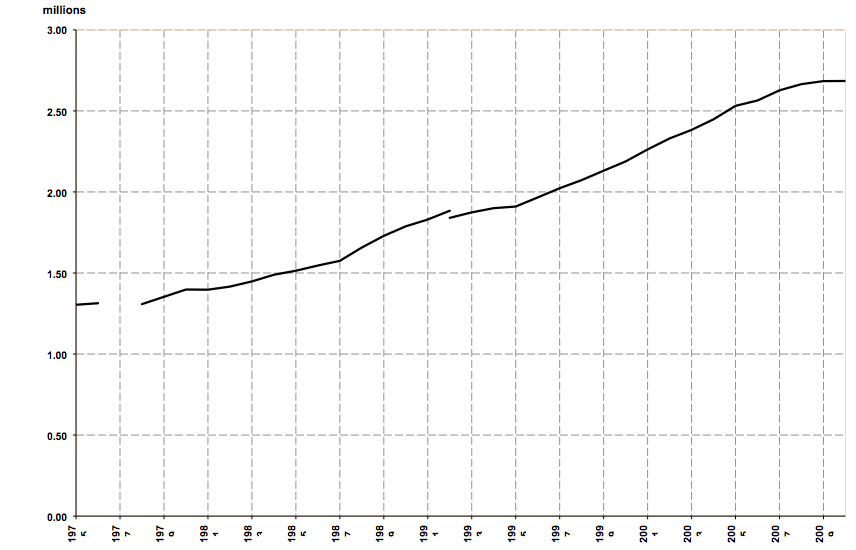
NB: breaks exist in the series due to changes in the collection process. Collection moved from local taxation offices to the DVLA (annual vehicle census) in 1978 while figures from 1993 onwards originate from the DfT Vehicle Information Database.
Figure 2: New registrations of vehicles in Scotland
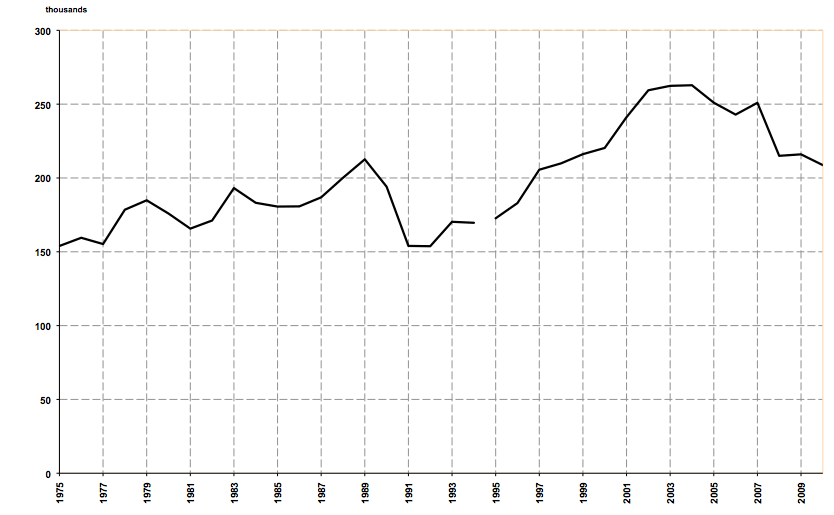
NB: a break in the series exists in 1994. Results prior to this are taken from DVLA geographical analysis with results thereafter estimated using post town area data.
Figure 3: Vehicles licensed per 100 population
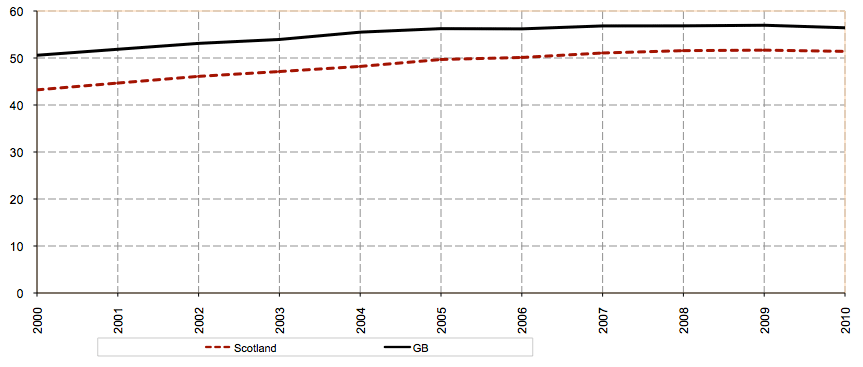
Figure 4: Traffic (vehicle kilometres) in Scotland
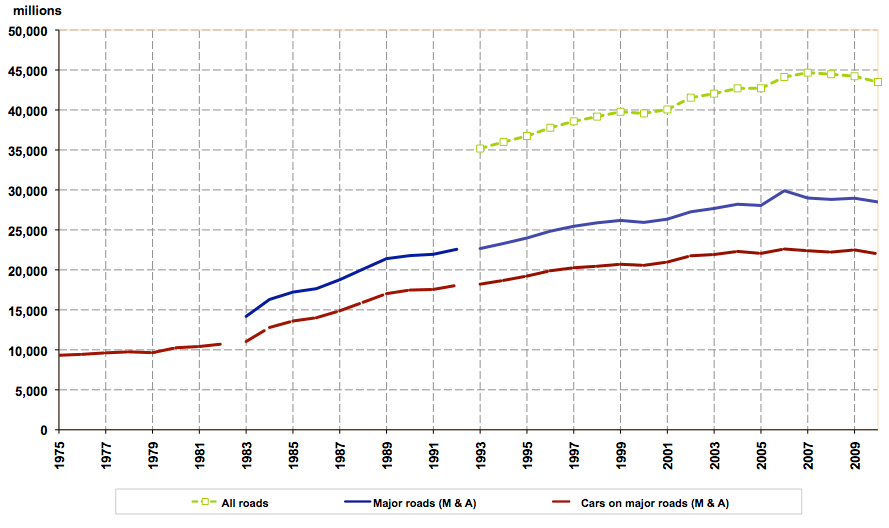
NB: breaks in the series exist as the DfT revised its method of estimating traffic volumes from 1993. Estimates of traffic on minor roads are not available prior to 1993.
Road traffic
3.3 The estimated total volume of traffic on Scotland's roads in 2010 was over 43 billion (thousand million) vehicle kilometres - 1.7 per cent less than 2009 and continuing the downward trend since a peak of 44.6 billion vehicle kilometres in 2007. Prior to this, the trend had been steadily upward, rising from 35.2 billion vehicle kilometres in 1993. [ Table S1]
3.4 The pattern in Scotland was similar to that for Great Britain as a whole. The total volume of traffic for Great Britain fell by 1.6 per cent between 2009 and 2010, from a peak in 2007. [ Table SGB1].
3.5 Figure 4 shows the longer-term trends in Scotland. It is estimated that the volume of car traffic on major roads (Motorways and A roads) has more than doubled, from an estimated 9,300 million vehicle kilometres in 1975 to around 22,000 million vehicle kilometres in recent years. Figure 4 shows much of this rise was between 1983 and 1995.
3.6 Compared to Great Britain as a whole, Scotland had less traffic (per head of population) on Motorways, more traffic on A roads, and more traffic on all roads taken together (including B, C and unclassified roads). Despite accounting for 20 per cent of the road network, M and A roads account for two thirds of traffic in Scotland.
Traffic growth
3.7 In 2007 new questions were added to the SHS to collect information on concerns surrounding Traffic Growth. Sample sizes are small so the data has been combined for 2007-2010.
3.8 Fifty-three per cent of respondents were concerned about increased traffic on the roads. The most common concerns were 'increased traffic volume' (54%), 'increased travel times' (45%) and 'damage to environment' (33%). [ Table 22]
Possession of driving licenses
3.9 Over two thirds of respondents to the Scottish Household Survey aged 17 or over had a full driving licence in 2010, an increase of 3 percentage points since 2000. This varies with age, increasing from 27 per cent in 17 to 19 year olds to peak at 81 per cent of 40 to 49 year olds, before decreasing back down to 37 per cent of those 80 or over. [ Table 1]
3.10 There is a disparity in driving licence possession with regards to gender, with 76 per cent of males and only 60 per cent of females possessing a licence in 2010. However, due to an increase in percentage of females with a full driving licence since 1999, this gap has decreased from 25 percentage points in 1999 to 15 percentage points in 2010. [ Table 1] The gender gap is more marked in the older age groups than it is in the younger age groups, which explains why it is decreasing over the years as the population ages. [ Table 18] (Figure 5)
3.11 Household income is also a factor in whether a person holds a full driving licence, with 48 per cent of those in the lowest income bracket (up to £10,000 per year) holding a licence, compared to 90 per cent of those in households earning over £40,000 per year. [ Table 18]
Figure 5: Adults (aged 17+) with a full driving licence by gender, 2010
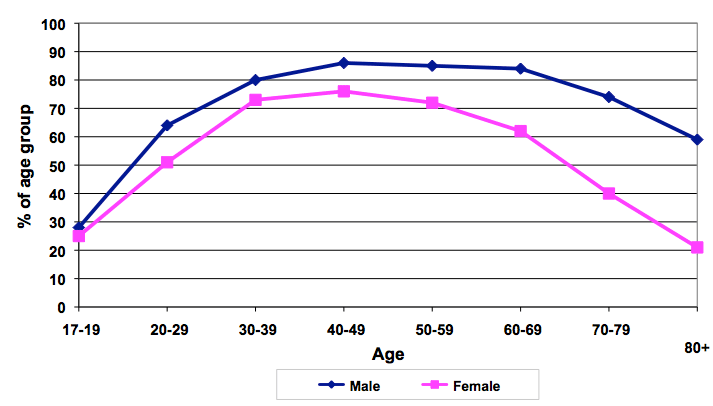
3.12 At GB level the patterns are similar. Seventy-three per cent of households had a full driving licence, with men more likely to own a licence than women (80% and 66%, respectively, 2010 NTS) and 30 to 59 year-olds were the most likely group to own a licence (81-84%).
Access to cars / vans
3.13 In 2010, there were 51 vehicles per 100 population in Scotland compared with 56 in Great Britain. Figure 3 shows that the number of vehicles per head of population has been rising steadily, and has been consistently lower in Scotland than in Great Britain, though the gap has narrowed over the last ten years.
3.14 The Scottish Household Survey shows there has been little change in the number of households with access to a car over the last few years. In 2010, 26 per cent of households had access to two or more cars, an increase of 7 percentage points since 2000. [ Table S3] Conversely, there was a decrease of 6 percentage points from 2000 (36%) to 2010 (30%) in the number of households with no access to a car. (Figure 6)
3.15 Households with only one adult (single adult, single parent & single pensioner) were the least likely to have access to a car in 2010. In particular, 62 per cent of single pensioner households had no access to a car, compared to 10 - 11 per cent for family households. [ Table 17]
3.16 Car access was found to be dependent on annual net household income (Figure 7), i.e. car access increased as income increased. Forty-one per cent of those households with up to £10,000 net income per year had access to at least one car, compared to 98 per cent of those in households with over £40,000 net income per year. Thirteen per cent of households in the highest income bracket had access to three or more cars. This may, in part, be due to household type, with higher earning household more likely to contain two or more adults. [ Table 17]
3.17 Forty per cent of households in large urban areas had no access to a car. This is more than double that of rural areas. This may reflect the necessity of a car in more rural areas in order to have access to services, such as food shopping and medical facilities. [ Table 17]
3.18 The patterns seen in the SHS results are similar to the trends and patterns seen across Great Britain using the National Travel Survey, Expenditure and Food Survey and the General Household Survey.
Figure 6: Household car access by year, 1999 - 2010
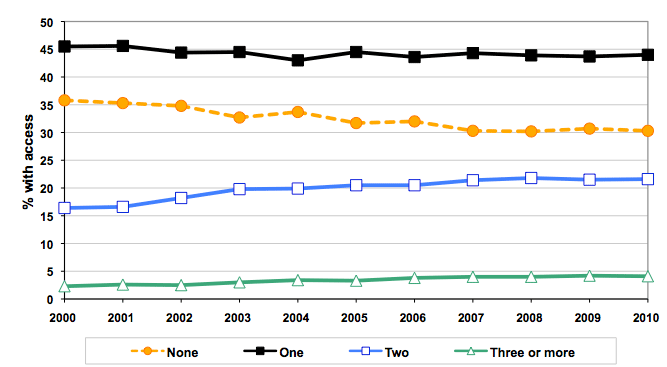
Figure 7: Household car access by annual net household income, 2010
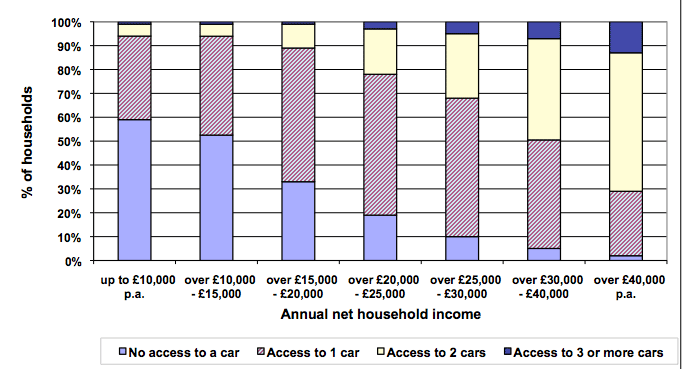
Frequency of driving
3.19 Sixty per cent of respondents drove at least once a week, and the majority drove on a daily basis (41%), a trend that has been stable since 2003. [1] [ Table S3] Those who said they drove at least 3 times a week (but not every day) rose from 8 per cent in 2000 to 13 per cent in 2010.
3.20 Employed respondents were more likely to drive every day. In particular, 68 per cent of self employed people drove every day, compared to less than 18 per cent of those unemployed or unable to work due to sickness or disability. [ Table 19]
3.21 Respondents aged 30 to 59 were more likely to have driven every day than younger and older respondents, and men were more likely to have driven every day than women.
3.22 Fifty-one per cent of respondents living in large urban areas drove a car at least once a week. Over three quarters of those living in rural areas drove at least once a week, with over half driving every day. [ Table 19]
Income
3.23 Those in high income households were more likely to drive at least once a week. Eighty-seven per cent of those in households with an income of over £40,000 per year drove at least once a week compared to 35 per cent of those in households earning up to £10,000 per year. [ Table 19]
Car location overnight
3.24 About half of respondents keep their cars on a driveway or land attached to their home overnight, a third on the street and one fifth in a garage. The majority of garages are attached to, or on the land of, their home.
Park & Ride
3.25 In 2007 new questions were added to the survey on Park & Ride use in Scotland. Park & Ride facilities allow drivers to park at dedicated car parks and continue the rest of their journey via public transport, such as bus or train. In most cases either the parking or the bus/train fare are free. Due to small sample sizes, responses on Park & Ride from the 2007-2010 Scottish Household Survey have been combined in order to produce more robust results.
3.26 One in five respondents had made a journey in the last month where they chose to drive only part of the way, and completed their journey using another form of transport. Of these, 28 per cent parked in a designated Park & Ride facility and a further 28 per cent used an ordinary car park at a bus or train station or airport. The remainder parked on the street or used a public car park. (Figure 8) [ Table 20]
Figure 8: Where parked last time undertook a part driving, part parking journey, 2007-2010
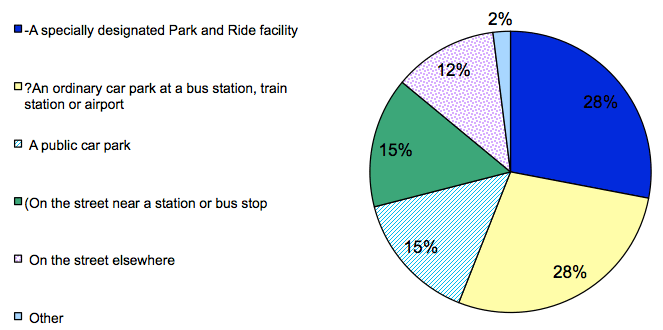
3.27 Nine per cent of respondents had made a journey where they could have used a Park & Ride facility but chose not to. The main reason for not using the Park & Ride was that the 'journey would take longer'.
3.28 Nearly half of those who had made a part driving/parking journey continued their journey by train, 29 per cent used the bus and 17 per cent walked to their destination. This varied depending on the location that they parked, with almost half of those who used a designated Park & Ride facility continuing their journey by bus or train compared to only 9 per cent of those who chose to park in an ordinary car park at a bus or train station or airport. Those who parked on the street (not near a station or bus stop) were more likely to walk to their destination than to take the bus or train. (Figure 9) [ Table 21]
Figure 9: Mode of transport used to complete part driving/parking journey, 2007-2010
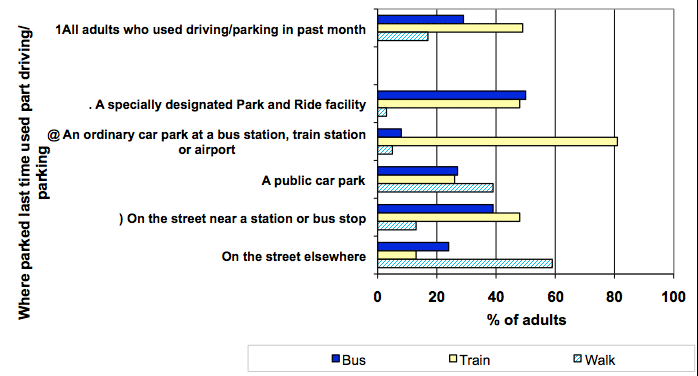
Motorbikes
3.29 Four per cent of respondents had ridden a motorbike in the past 12 months in 2010. This figure has been stable since 2005. The most common reasons given for motorcycle trips were 'day trip', 'travel to work' and 'visiting friends/relatives'.
Fuel spend
3.30 Twenty-seven per cent of households reported spending over £150 on fuel for their cars in the last month, increasing from 21 per cent in 2009 and doubling since 2004. [ Table 2]
3.31 Households reported an average spend of £112 on fuel for their cars in the past month - up from £100 in 2009 and £78 in 2003. The median spend reported in 2010 was £80 which was the same as in 2009 but an increase from £60 in 2003. This is perhaps expected due to households' increasing access to cars as well as a known rise in distance travelled (vehicle kilometres) and sole occupancy car journeys. However it is below the level of inflation experienced by fuel prices ( RPI data shows this to be 54% between 2003 and 2010). Care should be taken when using SHS figures as they are based on a sample survey and will be estimated spend by household members. [ Table 2]
Road rage
3.32 In 2007 new questions were added to the SHS to collect information on experiences of road rage. Sample sizes are small so the data has been combined for 2007-2010.
3.33 Forty-four per cent of drivers experience road rage directed at them, the majority of whom recalled 1-2 incidents in the past year. Of those experiencing road rage directed at them, almost a quarter felt there was a threat to their personal safety. [ Table 23]
Reported road casualties
3.34 Provisional figures for 2010 were published in Key Reported Road Casualties Scotland in June 2011. Final figures for 2010, taking account of late amendments to the data, will be published in Reported Road Casualties Scotland 2010 in October 2011.
3.35 The provisional figures show there were 208 road deaths reported in Scotland in 2009, 8 (or 4%) fewer than in 2009, and the lowest figure since current records began. 1,960 people were reported as seriously injured in road accidents in 2010, 14 per cent less than in 2009. Over the past ten years, the number of people reported injured in road accidents has fallen by 35 per cent to 13,324 in 2010. Figure 10 shows falls in most years since 1979 and indicates a general downward trend in road casualties
3.36 Since 2000, the fall in the number of people killed or seriously injured in road accidents in Scotland has been slightly better than for Great Britain (50% lower compared to 41%). The number of people killed or seriously injured per thousand population was almost the same for Scotland as Great Britain in 2010 (around 0.4 per thousand population).
Figure 10: Reported road casualties*
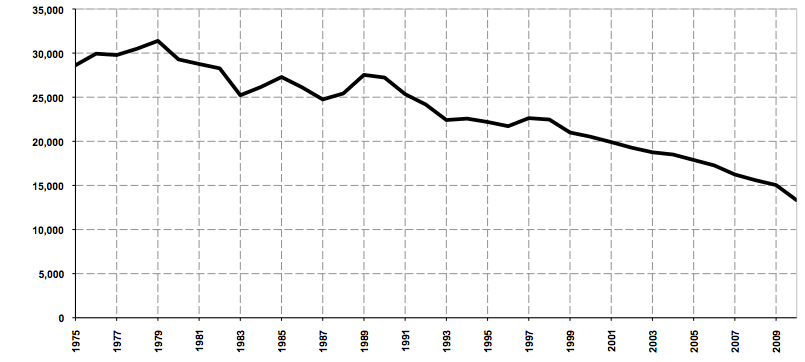
* figures for 2009 are provisional
There is a problem
Thanks for your feedback